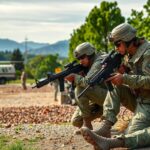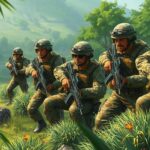Congo-Kinshasa: The Role of Burundi Troops and Hutu Rebels in M23’s March on Goma
The article discusses the conflict in Congo-Kinshasa, focusing on the impact of Burundian troops and Hutu rebels on M23’s strategy. Despite initial setbacks, M23 executed a counteroffensive that led to significant territorial gains, ultimately capturing Goma. The involvement of FDLR and the dynamics of coalition forces underscore the complexities of the ongoing conflict.
In recent developments in Congo-Kinshasa, Burundi troops and Hutu rebels significantly impacted the ongoing conflict, prompting the M23 rebels’ strategic retreat towards Goma. The FDLR, a UN and US-blacklisted militant group, has been a crucial factor in the tensions between Rwanda and the Democratic Republic of Congo (DRC). Lt Col Guillaume Ndjike Kaiko reported that the pro-Kinshasa coalition pushed back against the M23 in various localities, although the operation was supported by the FDLR and Burundian forces, highlighting a complex alliance.
The offensive began as the M23 observed a unilateral ceasefire in hopes of initiating peace negotiations. An M23 commander acknowledged the initial losses, stating the group strategically retreated to gain a tactical advantage against their opponents, who briefly occupied areas such as Bitagata and Ngungu. However, reinforcements allowed M23 to counterattack, successfully reclaiming lost territory and advancing further south.
By January 17, M23 forces had regained villages which they previously lost and were furthering their territorial expansion. The strategic importance of Minova—a key town on Lake Kivu—was underscored as it provided essential supplies to Goma. The Burundian troops aimed to recapture Rubaya, vital due to its mineral resources. The M23 alleged that Burundian motivations stemmed from a mercenary-like agreement with the Kinshasa government.
Following the initial conflict phases, M23 executed a calculated counteroffensive against the Burundi-FDLR coalition, decisively retaking Minova and surrounding territories. The rebel group employed guerrilla tactics and multi-front engagements to stretch the coalition’s resources thin. By early January, M23 had captured multiple important locales in South Kivu, aligning their movements for an expanded offensive.
On January 23, the battle for Mubambiro escalated, requiring M23 to confront new challenges from coalition reinforcements that included South African soldiers under the SADC Mission. Despite favoring a hands-off role, SAMIDRC inadvertently became involved, turning the tide against the M23, leading to fierce clashes. Ultimately, M23 achieved dominance, inflicting significant losses on the coalition and capturing valuable assets.
As M23 advanced towards Goma, they faced further confrontations, including the unintentional killing of North Kivu provincial governor Gen Peter Chirimwami. The rebels managed to advance rapidly through many strategic locations on the road to Goma, leading to its eventual fall on January 28, indicating a decisive victory for the M23 and altering the landscape of the regional conflict.
The recent conflict dynamics in Congo-Kinshasa reveal the intricate relationships among various armed factions, particularly the role of Burundian troops and the FDLR in catalyzing M23’s resurgence. Despite initial setbacks, M23’s strategic counteroffensive led to significant territorial gains and the ultimate capture of Goma, illustrating the volatility and complexities of the regional power struggles. As the situation unfolds, the implications for peace efforts and regional stability remain uncertain and require continued attention.
Original Source: allafrica.com








Post Comment